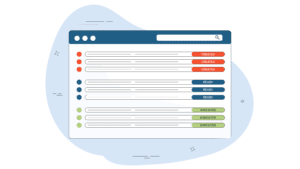
It is early days at ProcurementExpress.com. The app is doing a great job for early customers helping them put an approval process around their company purchases. Adoption rates have be huge. The only challenge now is to figure out how to acquire more customers like the ones that we already have.
As well as some other techniques, we have rolled out an outbound strategy, approaching companies we think could benefit from the solution. Inspired by Aaron Ross’ Predictable Reve
nue, here is exactly what we are doing.
The benefits of inbound are well documented, but the fact remains that there are large swathes of potential customers who never go looking for a “software app” or other service that could make their lives easier. They struggle on with their pain in private and go home at the end of the day to do it all again the next. In our case, there are plenty of companies that have implemented painfully inefficient, circumvented, ridiculed and time consuming paper based purchasing controls. They have no idea there is a better way out there. Outbound seeks to get to these people.
No Spam
This strategy involves buying lists of email addresses like it’s 1995. We purchased 500,000 email addresses broken down by industry sector for just under 200 GBP. We won’t be mailing most of them however. Instead this database is our seed list of potential people to work with.
Step 1: There are a good few options out there when it comes to buying contact information. They range from targeted and fairly expensive, to cheap and un-targeted. The options we looked at were
- DatabaseUSA: $439 for 2,439 emails. We actually had a hard time deadline with databaseUSA. It was surprisingly difficult to get a quote. We took that as a bad sign.
- Data.com (aka: Salesforce): ~$400 per month for ~ 350 targeted leads. They have a very fancy system that allows you to select leads by SIC code and bring them straight into your Salesforce account, which they require a subscription for.
- https://businessemaildirectoryuk.co.uk: $210 for 16,000 unique email addresses at 3,000 charities. Charities are one of our target segments.
The list we bought in the end was from the last provider mentioned here for a much broader number of contacts. We got some very basic industry breakdown of the contacts, but that was about it.
Step 1a: We haven’t done this, but a subscription to FullContact would allow us to enrich our basic list of emails with extra social information. Their middle tier lists at $499 which may be money well spent to be able to carry out the following steps. You’ll see why now.
Step 2: Our aim is to send out about 150 emails a day per Business Development Representative or BDR. A BDR has the job of hunter-gathering prospects for a quota carrying sales team member. That means they come up with creative applications for ProcurementExpress.com and find businesses who could benefit from our offering. Our app can be used by many different types of companies, and in a way, that makes it harder for us to find those that would benefit most. That means we have to bridge the gap between what our customer needs and what we do through targeted messaging that explains how much better we could make life for them. So lets go through the work day of a BDR.
They start off with their tracking sheet, which should look something like this:

- 9:30am: Enter a new date into the tracking sheet, today’s date.
- 9:32am: Crack open our database of leads and start to browse the information we have on each.
- 9:40: Go the CRM and see how many people from earlier campaigns have turned into leads. Update the spreadsheet accordingly.
- 10am: Start writing down ideas for how ProcurementExpress.com could benefit a segment. There are literally an infinite number of companies out there that could use better purchasing controls. The hard part is coming up with a hook that will get their interest enough to open and read our outbound mail.
- 10:30am: With a short of potential uses, come up with hooks that could entice the recipient into finding out more. A hook comprises of the subject line and first line of the opening email.
Example Hooks
Creating a hook is not easy. You need some reason for the recipient to treat your mail as relevant to them and not just another mass mailer. For example, on outbound mail targeted only 31 people, TV production company producers. The subject line was “Production Costs” – something that producers live and die by, and the opening line explained where we came across their details and quickly told them we had something that could help control costs.
Our existing customers also provide inspiration for who we should target. Our marquee client, UNICEF, is a well known brand. We are able to reference them when reaching out to other charitable organisations.
We have also experimented with less up front emails as hooks. Asking short questions like “who deals with purchase orders”. Obviously, a lot of people think we have an invoice to raise and they direct us to the right person. The conversation soon peter out when they realise that in fact we have something to sell. It generates work for the BDR but not a lot of positive outcomes. It seems as though a more up front email works better.
- 11am: Having prepared a “hook” email, the mass email list is consulted to find suitable targets. 100 – 150 people are put into a cohort and selected. We use the subject line to differentiate between the outbound mail campaigns. That means when someone replies we can track it back to the particular outbound mail.
- 12 noon: Check and follow up with the replies from the previous days. We use our Ideal Customer Profile to sort through the responses and see if there could be a fit. If there is, then that person is added to the CRM for follow-up.
Of course this all gets boring a long time before it gets profitable, which is why the tracking sheet is so important. It gives you perspective on the effort. It will take weeks (if not) months for leads to start filtering through. The first month may result in no conversions at all, the second a paltry few. We are assuming a 0.1% conversion rate from the campaign but with a 3 month sales cycle. If you are going to attempt this strategy, make sure you have enough fuel in the tank to prove it out.
So should you be doing this?
Probably not. We are at the early stages of finding our market. This allows us to quickly test market messages against a wide range of segments. Every sale starts with capturing interest. Much like AB testing advertisement headlines, we can test a range of attention grabbing messages against relevant targets, fairly inexpensively. As we grow, we’ll get a lot more targeted, but for now, I think this is a good strategy for finding where your niche may be.
What do you think?



